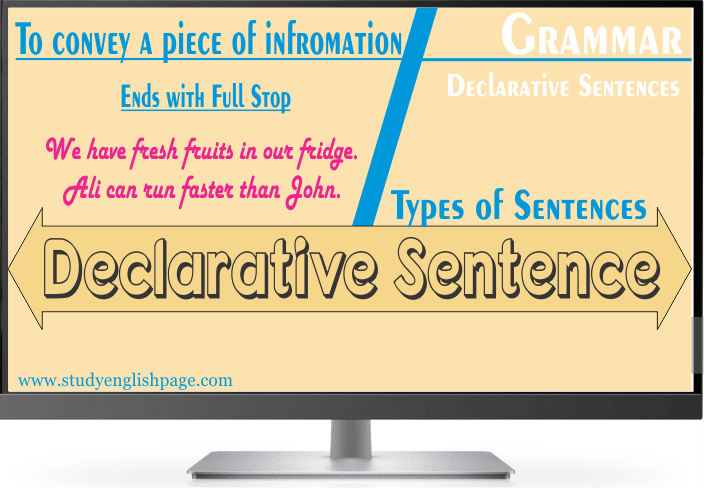A Declarative Sentence
Review of Sentence
We use words to put thought
into speech or writing. A group of words that is a complete thought put into
words is called a sentence.
- We are learning declarative sentences.
- She works as a manager at Mobilink.
Functionally, there are four
types of sentences: declarative sentences, questions, commands, and
exclamations. The most common type is a declarative sentence which is discussed
in this content. The remaining types are available on the site Study EnglishPage.
What Is a Declarative Sentence?
A declarative sentence is used
to convey a piece of information, state a fact, or make a statement. It always ends with a period or full stop.
A declarative sentence needs at
least a subject and a predicate that make up an independent clause.
- Ali can run faster than John.
- They don’t trust what we suggest to them.
Examples of
Declarative Sentences
- I have a laptop.
- Ali is from Pakistan.
- We have fresh fruits in the refrigerator.
- She always buys expensive clothes and cosmetics.
- They have planned to go on a trip to New York.
- He tried his best to win the elections but failed.
- Diya is someone who does not share her ideas with everyone.
- They asked if I wanted to go on a trip with them to New York.
- When I get exhausted from work, I call my friends to go outing.
- I would answer that my favorite food is rice with chicken if I were asked.
Word Order in Declarative Sentence
The word order in a declarative
sentence is simple.
Subject + Verb + Object
We have the subject at first followed
by the verb, and then we have the object. Sometimes, declarative sentences don’t
need objects. They have only subjects and predicates.
We can also add other parts, such as phrases and subordinate clauses. We can use them at the beginning or the end. We can also add transition words preceded by subjects.
Negative Declarative Sentences
A negative declarative sentence
is a sentence that conveys information in negative form by using ‘not’ or
‘never’. You can also use some other words of negation such as nowhere, none,
nobody, neither, etc.
- I do not know the exact figure of disabled persons in our country.
- He has not sent me an invitation card yet.
- Ali never speaks rudely.
Types of Declarative Sentences
A declarative sentence requires
at least one independent clause just like other sentences. When we talk about
types of sentences structurally, they are based on having clauses like simple
sentences, compound sentences, complex sentences, and compound-complex sentences.
A declarative sentence can have
one independent clause, two independent clauses, one independent and at least
one dependent clause, or at least two independent clauses and at least one
dependent clause.
- I like taking tea.
- I like taking tea, but I don’t like taking tea with chips.
- They will succeed if they work hard.
- When I decide, I think about it at first, and then I take the suggestions of friends.
Functions of a Declarative Sentence
The main function of a declarative sentence is to make a statement. It is used to convey information.
- Snowflakes are white.
- John is writing something special.
Key points related to Declarative Sentences
Declarative Sentences Used for Asking
As we know that we use
questions or interrogative sentences to ask about something; however, we have
some questions that have declarative clauses. They are used to clarify
information.
- You didn’t call him?
- Ali is present today?
- You think we are all mad?
Generally, we use the sentences
like above in speech. We change our tone in these sentences. A slightly higher
tone near the end of the sentence is used to show that we are asking, but not
conveying information.
In writing, we replace just a
period with a question mark. Remember that if a question mark and period are interchanged, and the sentence is still working, it is a declarative sentence.
Indirect Questions
An indirect question is a
question that is embedded inside a declarative sentence and is ended with a full
stop.
- She asked if I liked taking tea.
- He asked me what my name was.
The above sentences are
declarative sentences and questions are embedded inside the declarative
sentences.
Word order is the same as for
declarative sentences. When a direct question is a yes-no question, we start the
indirect question with whether or if.
Negative Declarative Vs Negative and Interrogative Sentences
In negative declarative
sentences, we use not or other words of negation. These words must be used
after the subject. Negative and Interrogative sentences also have the words of
negation; however, the order of words is different. Not with auxiliary is used
before the subject in American style. In British style, we use auxiliary + subject
+ not.
The second thing is using punctuation marks. Negative declarative sentences are ended with a full stop
(period). On the other hand, Negative and Interrogative sentences are ended
with a question mark.
- You don’t need to try further. (Negative Declarative)
- Didn’t you remember the meeting? (Negative and Interrogative)
- Did you not remember the meeting? (Negative and Interrogative)
Thank you for visiting Study
English Page.
Related Links:

